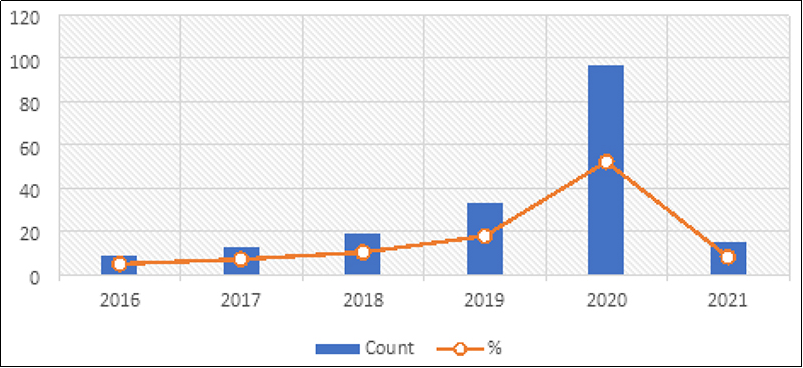G20 -Digital Health Decade of India
Transversing through the Decade of India’s Digital Health Journey – A decade of Rapid growth, COVID led renewed interest and the need to focus on sustainability.
In 2016 a group of researchers from, New Delhi published a review titled “Current Status and Future Directions of mHealth Interventions for Health System Strengthening in India”. The study focused on mHealth research in India between 2012 and 2016.
A sharp increase was seen after 2012 in mHealth-related initiatives, driven primarily by noncommunicable diseases (Diabetes, Stroke, Hypertension, Cervical Cancer, Breast Cancer and Oral Cancer). The majority of the primary studies had their sites in the south Indian states, with no published articles from Jammu and Kashmir and the North-Eastern parts of India. The primary focus of 57.6% (72/125) of the selected articles was service delivery which included telehealth, and telemedicine, behaviour change communication, reminders for a refill of medication or visit to the provider.
The authors also concluded that more than 91.2% of the studies, which lacked a sample size justification, had used convenience sampling. The methodological rigour of the selected studies was poor as most of the studies had a high risk for bias in the designing phase.
However one thing was clear, there was rising interest in mHealth among healthcare researchers and providers in India. Another study conducted in India in 2018 by researchers from the Institute of Health Management Research, Bangalore (IIHMR B) on Non-Communicable Diseases specific mHealth initiatives found that Geography-wise 60% of the mHealth initiatives on NCDs were targeted at Rural populations. Tamil Nadu (n =10) reported the most number of studies, followed by Andhra Pradesh (n= 8), Himachal Pradesh (n=4), Maharashtra (n=3), Karnataka, New Delhi, Uttar Pradesh (n=2 for each state), and Odisha (n=1). 70% of all the mHealth initiatives on NCDs were focused on Primary care (small clinics, OPDs), whereas Secondary and Tertiary care contributed to 30%. Diabetes was the most researched condition, followed by Cardiovascular Diseases and Hypertension, other commonly researched conditions were Ophthalmic disorders, Mental health, Stroke and Health systems strengthening for NCDs. The notable findings from the study were
- The mHealth initiatives in India are currently picking up traction in India, but the system is highly fragmented with most initiatives being undertaken to resolve locally faced issues with the help of technology.
- The academia and industry largely work within their own silos and this has led to studies concentrating on particular health verticals, while other are being neglected.
- Comparing India and China both the countries are with large rural populations and high penetration of mobile and internet service with cheap data availability and are currently front runners initiating mHealth initiatives for strengthening health care systems and none of the countries has a system in place to register and track the progress of mHealth initiatives and to aid in continuous knowledge updates and policy making.
In 2018 WHO released its Digital Health Strategy for 2020-2025, the term Digital Health was coined as a broader term encompassing the earlier used terms like mHealth, eHealth, Telehealth, Health IT. The Vision presented by WHO is dedicated towards promotion, the adoption and scale-up of digital health and innovation. The three key objective stated by WHO to achieve the goal were
- Translating latest data, research, and evidence into action: this means promoting standards for interoperability and data sharing and supporting implementation of digital solutions that contribute to informed decision making.
- Enhancing knowledge through scientific communities of practice: enabled by new technologies and no longer limited by the need for physical meetings or hard copy peer review journals, WHO brings together top expert voices around topics of clinical and public health significance.
- Systematically assessing and linking country needs with supply of innovations: all too often in global health, products are developed with the attitude of “if you build it, they will use it.” This approach has failed time and again. WHO takes a proactive, systematic approach to identify, promote, co-develop, and scale innovations that are based on country needs.
The COVID-19 pandemic accelerated the achievement of the stated objectives. A study in 2021 by researchers from the Institute of Health Management Research Bangalore (IIHMR B) undertook the review of progress made in India and SAARC countries before COVID and during the COVID pandemic. The graph depicts the story in terms of sheer number of increase in Digital Health Innovations (40% rise between 2019 to 2020).

In terms of technological innovation, 11 categories emerged. (Presented in Table 1)
| Name of the Student | University/College | Topic of Research | Faculty Mentor | Duration |
|---|---|---|---|---|
| Ms Bhawana Shivakoti | Mount Carmel College, Bangalore | Dr Jyoti Vijay | 26th May to 25-July 2025 | |
| Ms Sugandhita Devi | Mount Carmel College, Bangalore | Dr Jyoti Vijay | 26th May to 25-July 2025 | |
| S Apurva Ananya | PES University | Dr Falguni Pandaya | 9th June 1st August | |
| Sahil Siddiqui | Padmashree School of Public Health | ECCD (Early Childhood Care Development) Project | Dr. Sarala R | 9th June to 6th Sept 2025 |
| Saraswathi P | Mahatma Gandhi Rural Development and Panchayat Raj University Gadag | ECCD (Early Childhood Care Development) Project | Dr. Sarala R | 21st July to 21 October 2025 |
| Dr Shrilath Kumari | Mahatma Gandhi Rural Development and Panchayat Raj University Gadag | 21st July to 21 October 2025 | ||
| Ravi D | Mahatma Gandhi Rural Development and Panchayat Raj University Gadag | Nikshya Poshan Abhiyan in TB | Dr Rajeshwari | 21st July to 21 October 2025 |
| Kishora KR | Mahatma Gandhi Rural Development and Panchayat Raj University Gadag | Adolescence Health | Dr Rajeshwari | 21st July to 21 October 2025 |
year on year trend analysis of digital health tools used, presented an average annual increase in Health Information Exchange tools recorded 5% annual increase, under HIE, Remote consultation recorded a 9% average annual increase, followed by a 7% increase by Health Information Delivery. Data Science tools recorded a 0.5% annual increase, under Data science tools only Clinical Decision Support Systems recorded a 2.5% average annual increase, whereas Big data Mining, Predictive Analysis and Patient-Generated Health Data tools recorded a negative year-on-year trend.
The Surveillance tools usage trend presented a 0.5% average annual increase for 2016-2021 with Real-time Data Collection and Visualization tools showing a 2% increase.
The key findings of the study were.
- COVID-19 pandemic has positively impacted digital health research with a 40% increase in the number of studies report in 2020 when compared to 2019.
- The three most common diseases and conditions wherein substantive digital health research has been focused are Health Systems Strengthening, Ophthalmic Disorders, and COVID-19.
- Remote Consultation, Health Information delivery and Clinical Decision support systems are the top three commonly developed tools from 2016 -2021.
The authors also develop a tool to ascertain the sustainability of various digital health innovations. To ascertain sustainability a 5 questions tool was used with answers of Yes, No, Can’t Say was developed as presented in Table 2
| Name of the Student | University/College | Topic of Research | Faculty Mentor | Duration |
|---|---|---|---|---|
| Mr Akash Joshi | Ramiah University, Bangalore | Dr Sarla R | 2nd January to 2nd May 2024 | |
| Ms Duwa Mohammed | Ramiah University,Bangalore | Dr Sarla R | 2nd January to 2nd May 2024 | |
| Ms Saba Waheed | Ramiah University, Bangalore | Dr Sarla R | 2nd January to 2nd May 2024 | |
| Ms Sowmya Bai M | Ramiah University, Bangalore | Dr Sarla R | 2nd January to 2nd May 2024 | |
| Mr Ankur | ||||
| Angela Shreshta | Mount Carmel College, Bangalore | Dr Jyoti Vijay | 21 May 2024 to 6th July 2024 | |
| Teesta Dey | Mount Carmel College, Bangalore | 21 May 2024 to 6th July 2024 | ||
| Athmakoor Angela | Mount Carmel College, Bangalore | 21 May 2024 to 6th July 2024 |
The analysis of the sustainability component indicated the number of digital health intervention research increased significantly during the COVID-19 pandemic, and most authors took initiative to have oversight on the sustainability of their digital health initiatives.
When compared across the SAARC nations India had the most number of initiatives documented. The decade between 2012 to 2021 has been monumental in shaping the digital health journey of the country. The huge gap between healthcare service access and demand could be effectively bridged by using digital health innovation. The Ayushman Bharat Digital Health Mission (ABDM) was a much-needed policy initiative that the Government of India enforced at the right time. The policy push and resources through ABDM will lead to the institutionalisation of digital health innovation in the next five years and more importantly create and support an ecosystem of healthcare providers, healthcare systems and the citizen creating demand for digital health innovation.
Under the able leadership of Prime Minister Shri Narendra Modi, India has leapfrogged strengthening the framework, systems and processes to lead the world in the arena of Digital Health. Various developing countries in the G20 group could easily adopt the frameworks and processes created by India and rapidly scale up the Institutionalisation of Digital Health Innovations. Thus, improving access to healthcare for billions of individuals across the globe. Truly applying the motto of Vasudhaiva Kutumbakam of 2023, India’s year of G20 presidency.
Authored by –

Dr Usha Manjunath, Director
Institute of Health Management and Research, Bangalore (IIHMR-B)

Dr Akash Gajanan Prabhune, Assistant Professor,
Health and IT,Institute of Health Management and Research, Bangalore (IIHMR-B)










